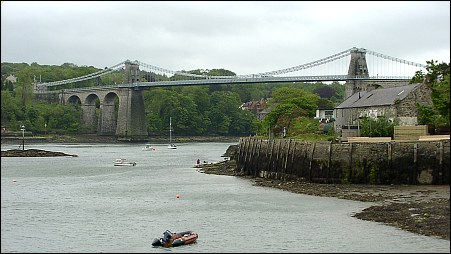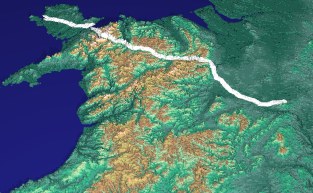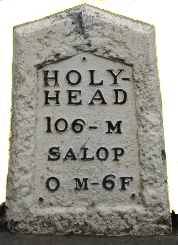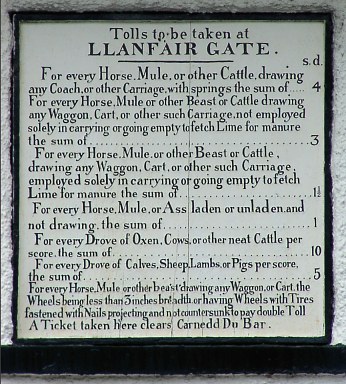


 The story of the
Holyhead road wouldn't be complete without the mention of Thomas Telford, talented
Scottish engineer who was tasked with improving the London to Holyhead road. The port at
Holyhead was the start of the sea crossing to Dublin, Ireland, and this route gained
importance with the Act of Union, 1800. Sir Henry Parnell was the Irish member of
Parliament and knew from firsthand experience how the journey across Wales was difficult
and dangerous. Improving the transport connections with Ireland was important, as more
traffic and information flowed across the land, but Ireland was cut off either by a long
sea journey, or by the forbidding mountain fastness of Snowdonia in Wales.
The story of the
Holyhead road wouldn't be complete without the mention of Thomas Telford, talented
Scottish engineer who was tasked with improving the London to Holyhead road. The port at
Holyhead was the start of the sea crossing to Dublin, Ireland, and this route gained
importance with the Act of Union, 1800. Sir Henry Parnell was the Irish member of
Parliament and knew from firsthand experience how the journey across Wales was difficult
and dangerous. Improving the transport connections with Ireland was important, as more
traffic and information flowed across the land, but Ireland was cut off either by a long
sea journey, or by the forbidding mountain fastness of Snowdonia in Wales.
 By far the greatest part of the work
involved was from Shrewsbury to Holyhead - as the relief picture shows Telford had to
negotiate the mountains. One of the objectives was to bring the mail faster as Ireland -
the post would managed an average of 10 miles an hour on staged horses but this dropped
abysmally in the mountains.
By far the greatest part of the work
involved was from Shrewsbury to Holyhead - as the relief picture shows Telford had to
negotiate the mountains. One of the objectives was to bring the mail faster as Ireland -
the post would managed an average of 10 miles an hour on staged horses but this dropped
abysmally in the mountains.
Telford surveyed the route and presented his plans to Parliament in April 1811, though it took another four years of prevarication before funds were authorised in 1815. Seven turnpike trusts already controlled the route, and Telford showed people skills as well as engineering skills in negotiating the amalgamation of these to take control of the entire road.
The route from London to Shrewsbury was relatively easy, and much of it had been pioneered centuries ago by the Roman legions when they constructed Watling Street. It was the 106 miles from Shrewsbury to Holyhead that Telford worked his magic. He shaped the route, taking much of the existing path used by the turnpike trusts but reducing the steep grade in places, bridging rivers and generally taking great care to ease the passage of travellers. It is a tribute to his work that the route of todays A5 follows the same path almost without change (as of 2002 - there appear to be steps to upgrade the road to a dual carriageway at the time of writing).
 Telford's design was good enough that todays heavy
trucks and high-speed traffic can travel five times faster than the stagecoaches of his
times, without coming off the bends or excessive gradients to climb. Telford adopted some
of the same technique the Romans had used, layering the roadbed first with large stones,
then covered with gravel and paying attention to good drainage which is the key to a
long-lasting roadway.
Telford's design was good enough that todays heavy
trucks and high-speed traffic can travel five times faster than the stagecoaches of his
times, without coming off the bends or excessive gradients to climb. Telford adopted some
of the same technique the Romans had used, layering the roadbed first with large stones,
then covered with gravel and paying attention to good drainage which is the key to a
long-lasting roadway.
Winding his way through Snowdonia was challenging enough, but a major challenge remained - replacing the ferry across the Menai Straits between Bangor and the Isle of Anglesey. This stretch was tidal with rapid currents in either direction. This often led to ferries capsizing and the occasional loss of life - in 1785 a boat carrying 55 people was stranded on a sandbar in high winds, and all but one had perished by the following day when the rescuers from Caernarvon reached the site.
Currents notwithstanding, the Straits had to be kept clear for shipping, meaning that the bridge needed 100 foot clearance to the water to clear the masts of sailing ships. Telford's solution was the elegant Menai Bridge, a suspension bridge. Work started in 1819 and was completed on the 30th January 1836 when the London mailcoach crossed the bridge for the first time. Once again the quality of Telford's work shows, in that the bridge is still in service carrying traffic today, though it has been reworked to strenghten the carriageway for modern requirements.
 Telford's solution was a full-service job - not only
did he design the route and arrange the contractors to build it, but he came up with his
own design for the elegant milestones on the route, designed the wrought-iron toll gates
and the toll-houses on the road - the toll-house at Llanfair Gate is probably the
best-known on the route. This striking building used to greet visitors as they passed over
the Menai or Britannia bridges on the old A5 en route for Holyhead, complete with replica
toll board!
Telford's solution was a full-service job - not only
did he design the route and arrange the contractors to build it, but he came up with his
own design for the elegant milestones on the route, designed the wrought-iron toll gates
and the toll-houses on the road - the toll-house at Llanfair Gate is probably the
best-known on the route. This striking building used to greet visitors as they passed over
the Menai or Britannia bridges on the old A5 en route for Holyhead, complete with replica
toll board!
index of stones by county | Guestbook